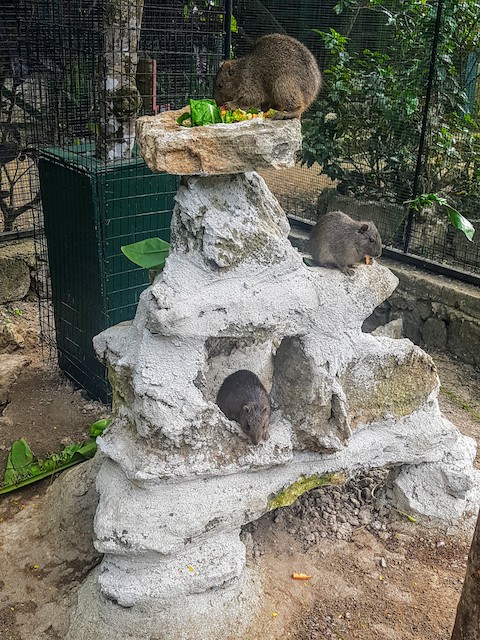Ardastra is celebrating the births of two hutias, the first babies of their kind to be born at the Zoo and Conservation Centre.
A critically endangered species, these rabbit-sized rodents are the only land mammal native to The Bahamas.
“We haven’t been hands on with the babies yet so we’re not sure of their sex,” said the facility’s animal curator, Bonnie Young.
The mothers, Coral and Sunny, were brought to New Providence last November, along with three male hutias – Junkanoo, Warderick “Ricky” and Raphael.
Originally from Warderick Wells Cay in the Exuma Cays Land and Sea Park, the animals were introduced to their new habitat in February of this year after a brief quarantine period.
“Most animals, when they make a move to a new area or are adjusting to a new habitat, it places stress on them. We really didn’t expect to start our breeding program until next year. We thought it was going to take them about a year to settle in and get used to life in the zoo, but they had other plans,” said Ms Young. “They apparently like the zoo, the cleaning service and the company that they are keeping.”
Although most people associate rodents with multiple births, the Bahama hutia bears one live young at a time after a gestation period lasting 85-120 days.
The first baby hutia was born in July, followed by the second in late August. The pair added to the community of five adults.
Considered an endangered species, the Bahama hutia is protected under the Wild Animals (Protection) Act. The International Union for the Conservation of Nature (IUCN) lists it as “vulnerable”. It is illegal to harm, capture or export this animal.
Once an important food source for the earliest inhabitants of The Bahamas, the Lucayan Indians, the hutia population dwindled over the centuries. They were thought to be extinct for most of the twentieth century until being re-discovered in 1966 on East Plana Cay – a small, uninhabited island in the southern Bahamas located east of Acklins and west of Mayaguana.
According to the Bahamas National Trust, in order to protect the species a small hutia population was transplanted from East Plana to two other cays, Warderick Wells and Little Wax. The latter is adjacent to the Exuma Land and Sea Park.
Up to the 1980s, the hutias on the three islands were thriving. Then, one of the communities disappeared. Based on the population of rats on Little Wax Cay, researchers believe they introduced a disease into the environment which wiped out the hutias there.
“The Bahama hutias are now only found in the wild on two islands,” said Ms Young. “If one of those islands had been hit by Hurricane Dorian, they might have been wiped out completely.”
The hutia babies are scheduled to have their first real human interaction, a doctor’s appointment, sometime this month. The vet check will reveal their sex.
“Whenever we have animals born in the zoo, we try to intervene as little as possible. Their best chance at survival is always going to be with their parents. As a prey animal, any type of handling could be very stressful for the animals and very risky for them, particularly with young babies,” explained Ms Young.
“We want to make sure they have a very good start to their life and intervene as little as possible until later in their development when they are sturdier.”

The five adult hutias in their exhibit shortly after their arrival to the zoo. Photos courtesy of Ardastra Gardens.

Considered an endangered species, the Bahama hutia is protected under the Wild Animals (Protection) Act. The International Union for the Conservation of Nature (IUCN) lists it as “vulnerable”.





